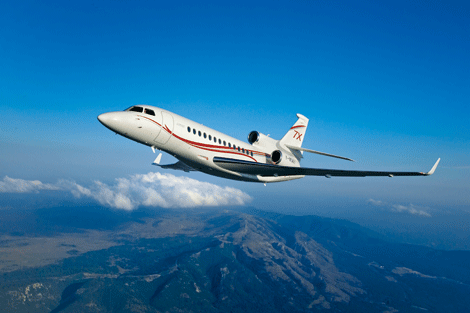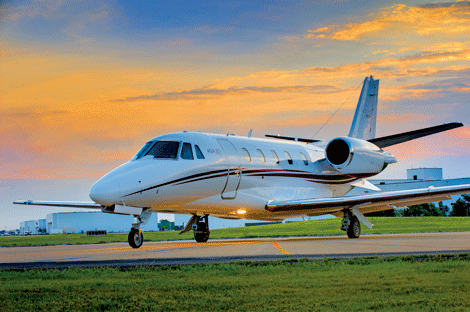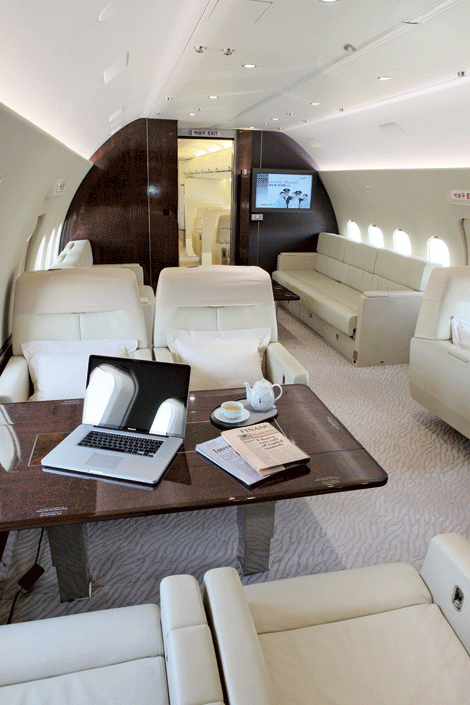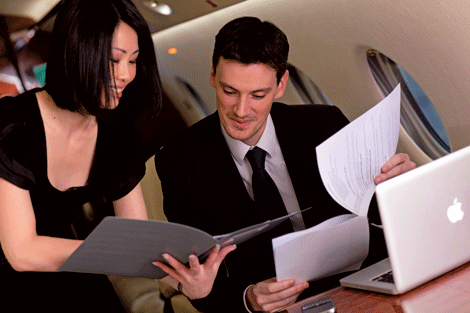
Despite the recent economic downturn, there is evidence that the business of corporate jets is still flying high, with emerging markets fuelling this growth.
In the last five years, the business jet fleet worldwide has experienced a 28 per cent growth – rising from 17,828 to 13,944 as of the end of January. In that period, the numbers in Asia, Africa and South America doubled to 1,230, 1,214 and 432 respectively, according to The Jet Business – a private jet showroom in London.

A Dassault Falcon 7X
So purchasing is on the up, but with multiple models and manufacturers to choose from, the process of picking a plane can be a daunting one. Steve Varsano, founder and managing director of The Jet Business, explains: “If someone said to me ‘I need a jet, what should I buy?’, well there’s 135 answers to that question. So you might think ‘how do I filter through all of this?’”
He’s got a point. There are different cabin sizes – from light to super-light, mid, super-mid and large – and different manufacturers, such as Gulfstream, Bombardier and Falcon, all producing models across the size spectrum, all in a constant race to make luxury aircraft that go higher, faster and farther than any other.
“Once you get beyond the name though, they are all as capable as each other,” says Neil Gibson, managing director of international aerospace services provider Gama Group’s new Hong Kong office.
The process of choosing a jet may seem akin to comparing very expensive apples – but there are some broad rules that help narrow the options. Both Gibson and Varsano agree that there are three golden questions to ask yourself: where are you going, what will you use it for, and how much are you willing to spend? Once these have been thoroughly explored, you will be much closer to finding the perfect private jet for you.

A Sessna Citation XLS+
Where are you going?
It’s important to suit your aircraft range according to your business patterns. For example, if you take business trips around Asia on a regular basis, but do a once-a-year meet in New York, you should opt for a mid-range jet to accommodate the regular trips rather than spend the extra on a large cabin jet that can reach the US. “If you start to fly every other month to a certain location, that’s really the range of an airplane you want to get,” explains Varsano.
Large cabin planes these days can fly up to 14 hours, a super-mid can go for 6.5 hours, a mid has a 4.5 hour flight range, while super-light and light can fly three and two hours respectively. Flight range can vary though, depending on passenger load and seasonal winds.
If you regularly fly farther than the range capability, fuel stops will have to be made. These can be costly, extend flight time and interrupt onboard working or sleep. On the other hand, if you use a larger aircraft to make short trips then fuel burn is increased, which is also not good financial practice. “If you use your jet to fly 85 per cent of its range 100 per cent of its time then the cost per hour really comes down significantly,” advises Gibson.
The distances people tend to fly from Hong Kong, for example, are greater than the average distance of flying around Europe or North America. It’s four hours to Singapore, 2.5 hours to Bangkok and 3.5 hours to Beijing. This leads you to a mid-size cabin category, rather than the super-lights that are more popular in North America.
Another consideration is the condition of the airports that you will fly in to on a frequent basis. Airports are split into four tiers regarding their landing conditions – first, second, third and fourth – with the latter two being more difficult. These may require aircraft that are tailored to such environments, says Gibson.
“Some aircraft have better short-field performance. If the airport is surrounded by high terrain – mountain, trees, radio masts, etc, the Dassault Falcon 900 and Falcon 50, for example, would be good as they have three engines and are terrific at short field takeoff and landing.”
First tier airports, meanwhile, often have separate private jet terminals and service centres, but there are landing fees and strict air space regulations – particularly in Asia – that make it more important to avoid fuel stops and ensure you have a jet range that can make it even if the direct beeline route is not available.
“In Asia, as soon as you leave a particular country you pay navigation fees and over-flight costs. There are only a few countries you can fly to from Hong Kong without paying over-flight charges, such as Taiwan, the Philippines and Macau. Fuel and the cost of using the VIP facilities run very high at premium airports such as Changi, Haneda and Beijing – and the heavier the jet, the more you’re paying,” says Chaand Sujanani from Asia Jet Partners, a private plane charter company.
China, for example, has tightly controlled air space that may mean you cannot fly in a straight line to your destination. In contrast, countries in Europe, Australasia and North America have an open skies policy that eliminates such considerations.
Given all these regulations, chartering a private jet is a popular alternative to owning your own jet. It still allows you to skip the lengthy queues connected with commercial travel and, considering your travel patterns, could be more cost-efficient than buying.
“We normally say if you are not going to fly more than 40 hours a year, there’s no point in buying… Sometimes travel is very seasonal, so it might be better to just charter since there is no obligation,” says Sujanani.

The interior of a Boeing Business Jet
What will you use it for?
When you buy a plane you are able – to some extent – to tailor the interior to your needs. You might want a desk or a foldout bed for practical purposes, or a lavish interior to impress clients. “You can configure it as you like, but weight absolutely matters on an airplane so the more you put on it the less distance you will fly – add more seats, bums, suitcases, fuel, and it’s not going to go as far,” Gibson points out.
On a personal level, you might prefer the oval windows of a Gulfstream to the square ones on a Bombardier, or you might want the vast interior options of the larger cabin airplanes, which can even accommodate showers. “The best is a subjective term. A Boeing Business Jet would usually have a permanent double bedroom in it, a shower, a private bathroom and it will have a salon for watching TV and having pre-dinner drinks, you could even have a cinema in there and a dining room,” says Gibson.
But for most corporate clients, the spaciousness of a large cabin (the Boeing Business Jet can cost up to US$93 million) is not worth the extra expense, and for these buyers, practicality often prevails when it comes to picking a private jet.
“A critical point is that 70 per cent of all corporate jets around the world are flying middle management people going to factories or going to look at sites or to meetings in three different cities in one day,” Varsano says. It’s a far cry from the days of high-flying executives taking the jet to their game of golf – a trend more common before the 2008 financial crisis.

How much are you willing to spend?
Generally speaking, the bigger the cabin the more you pay, but there is a way to get more plane for your pennies: by buying pre-owned. This is actually common practice, particularly post-2008 when the financial crisis both put more second-hand aircraft on the market, and changed the corporate climate to a more value-conscious mindset.
Buying pre-owned also allows you to get your jet faster, since new models often have a long waiting list. For example, the super-mid cabin Gulfstream 650 – the manufacturer’s newest model – has such a long waiting list that if you call up the factory today they can only deliver in 2017.
Pre-owned aircraft, however, may no longer be under warranty, and therefore require more frequent maintenance checks. They also may not hold their value as well as a brand-new model would.
According to Varsano, “Corporations like to have the newer stuff, they get the depreciation – the financial reasons for buying new – whereas the entrepreneurial people might be more apt to get something pre-owned because it is a discounted price.”
The Asian market has demonstrated a strong preference for new aircraft. Varsano suggests that this is because it is a less mature market and is thus unfamiliar with the older models. Gibson agrees, saying, “There’ll always be a segment where they always want the newest, the fastest, the longest range – and there’s a big segment of that in Asia.”
Decision time
Choosing a jet can be made simpler by considering components like range, destinations and usage – factors that narrow the options down considerably. The Jet Business showroom has even developed an app that clients can use to eliminate jets that do not fit their business patterns. The guidance of professionals is also invaluable when it comes to the technicalities of individual manufacturers and models, and what second-hand options are available on the market – elements that can help ensure that you eventually find the perfect private jet for you.
Insider tips
“It makes sense to charter the aircraft types you are considering before you purchase and try them out without any of the fixed costs or obligations. Enjoy hassle-free jet-setting first by going with a jet management company and paying a set fee.”
Chaand Sujanani,
Asia Jet Partners
“You see the same thing in real estate or cars – the top end holds its value much better, and the middle of the market is hurting in planes, cars, property – really anything – so there’s huge value there: these aircraft are fantastic in terms of what you get for your money, compared to what you would have to pay to get something one step higher… If you go to the super-mid and large cabin category, the best prices by far are in the Challenger 605 market, or if you go a little older the Challenger 604 market and the Falkan 2000 market.”
Steve Varsano,
The Jet Business
Top models
Boeing Business Jet
Cabin dimensions (LxHxW): 24.18 x 2.13 x 3.53 metres
Cruise speed: 515 knots
Approx range: 5,980 nautical miles
Approx price: US$71 million
Gulfstream G650
Cabin dimensions (LxHxW): 14.27 x 19.5 x 2.59 metres
Cruise speed: 500 knots
Approx range: 7,000 nautical miles
Approx price: US$64.5 million
Falcon 900LX
Cabin dimensions (LxHxW): 10.11 x 1.88 x 2.35 metres
Cruise speed: 459 knots
Approx range: 4,800 nautical miles
Approx price: US$42.4 million
Photos courtesy of Asia Jet, Korean Air, Gama Aviation and The Jet Business








